The Self-Sealing Bags Market is estimated to be valued at USD 4.3 billion in 2025 and is projected to reach USD 7.3 billion by 2035, registering a compound annual growth rate (CAGR) of 5.5% over the forecast period.
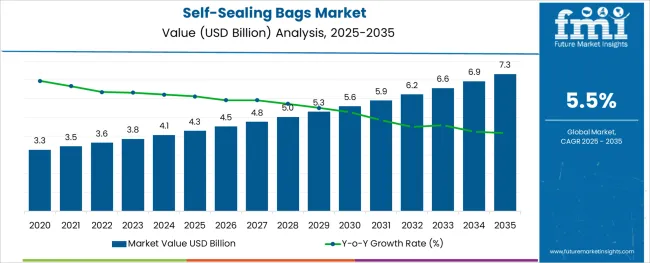
The self-sealing bags market is gaining steady traction globally, fueled by growing demand for user-friendly, tamper-evident, and resealable packaging across industries such as food, healthcare, e-commerce, and consumer goods. Increasing focus on hygiene and convenience, especially in retail and pharmaceutical applications, is boosting the use of self-sealing formats.
Manufacturers are adopting eco-conscious materials and smart sealing technologies to align with global sustainability goals and regulatory directives aimed at reducing single-use plastics. As automation in packaging processes rises, the compatibility of self-sealing bags with high-speed filling lines is also being prioritized.
In addition, direct-to-consumer fulfillment and online retail growth have expanded the need for packaging solutions that offer durability, security, and ease of handling. Innovations in film strength, printable surfaces, and closure mechanisms are expected to support new product development. Going forward, material optimization, mid-size packaging efficiency, and rising application in temperature-sensitive or sterilized products will continue to drive segmental growth across regional markets.
The market is segmented by Material Type, Bag Type, Bag Size, and End Use and region. By Material Type, the market is divided into Polyethylene, BoPP, and Cellophane. In terms of Bag Type, the market is classified into Renewable, Compostable, and Biodegradable.
Based on Bag Size, the market is segmented into 70-224 sq. inches, 224+ sq. inches, and 0-70 sq. inches. By End Use, the market is divided into Electronics and Consumer Goods. Regionally, the market is classified into North America, Latin America, Western Europe, Eastern Europe, Balkan & Baltic Countries, Russia & Belarus, Central Asia, East Asia, South Asia & Pacific, and the Middle East & Africa.
The market is segmented by Material Type, Bag Type, Bag Size, and End Use and region. By Material Type, the market is divided into Polyethylene, BoPP, and Cellophane. In terms of Bag Type, the market is classified into Renewable, Compostable, and Biodegradable.
Based on Bag Size, the market is segmented into 70-224 sq. inches, 224+ sq. inches, and 0-70 sq. inches. By End Use, the market is divided into Electronics and Consumer Goods. Regionally, the market is classified into North America, Latin America, Western Europe, Eastern Europe, Balkan & Baltic Countries, Russia & Belarus, Central Asia, East Asia, South Asia & Pacific, and the Middle East & Africa.
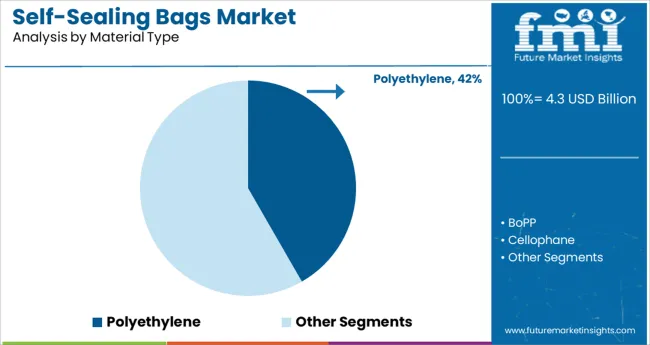
Polyethylene is anticipated to account for 41.7% of the total revenue share in 2025 under the material type category, making it the leading material used in self-sealing bags. This dominance is being driven by the material’s versatility, cost-effectiveness, and compatibility with a wide range of sealing technologies.
Polyethylene provides strong barrier protection against moisture, dust, and contamination, making it ideal for food, medical, and general-purpose packaging. Its ease of processing and ability to support high-speed manufacturing lines have positioned it as a preferred substrate among converters and packaging suppliers.
Additionally, the recyclability of certain polyethylene grades supports the market’s sustainability goals, particularly when paired with mono-material design strategies. These characteristics have continued to reinforce its widespread usage across both industrial and consumer-facing applications, securing its leadership in the material type segment.
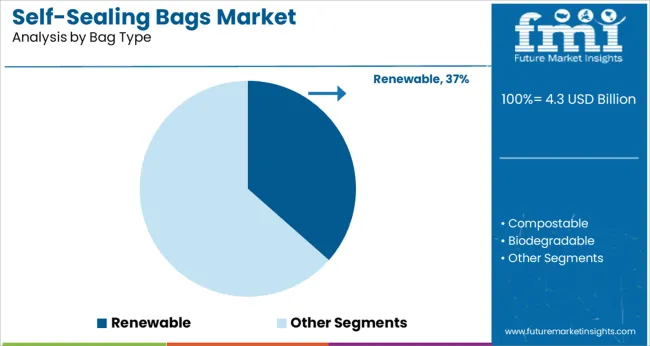
Renewable bags are projected to contribute 36.5% of total revenue in 2025 under the bag type category, placing them as the leading subsegment in this classification. This leadership is a result of growing environmental awareness and policy pressures to replace conventional plastics with bio-based or compostable alternatives.
Renewable bag formats made from materials such as polylactic acid or plant-based films are being increasingly adopted by brands looking to reduce their environmental impact and appeal to eco-conscious consumers. The shift toward sustainable packaging in food, cosmetics, and lifestyle goods has reinforced the adoption of renewable self-sealing bags, especially where branding and environmental positioning intersect.
Retailers and manufacturers are also responding to extended producer responsibility regulations by investing in packaging formats that align with circular economy principles. As demand for low-carbon, biodegradable packaging accelerates, renewable bag types are expected to maintain their growth trajectory and continue driving innovation in seal technology and material engineering.
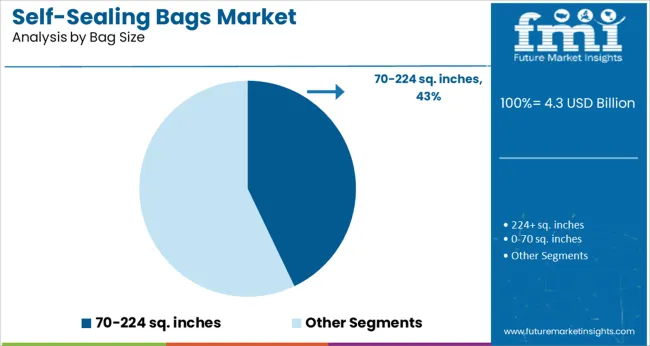
The 70 to 224 square inches size segment is forecast to command 42.9% of the market share by 2025, establishing it as the leading bag size category. This segment’s dominance is attributed to its optimal size range for packaging a diverse set of products including apparel, books, pharmaceuticals, electronics, and dry food items.
The mid-size configuration balances compactness and storage capacity, making it highly compatible with retail shelf standards and last-mile delivery formats. Its versatility has driven adoption among both direct-to-consumer brands and traditional brick-and-mortar players. In logistics and healthcare, this size supports efficient order fulfillment and secure handling while minimizing material waste.
Additionally, the 70 to 224 square inches format is often favored for its flexibility in custom printing, tamper-evident features, and reusability-all factors contributing to enhanced consumer experience. These advantages have led to its widespread use across end-use sectors, positioning it as the most commercially viable size segment within the self-sealing bags market.
The desire for an improved standard of living pertaining to an increase in disposable income of the consumers is predicted to expand the self-sealing bags market size in the coming years. Materialistic ownership of various commodities by the consumer is also playing a pivotal role in spiking the sales of self-sealing bags over the forecast period.
The advancements in packaging technology are expected to shape the self-sealing bags market's future trends across the globe. The global increment of production output of various products has directly boosted the growth of the self-sealing bags market. Plastic is a non-biodegradable material and has a negative impact on the environment.
Therefore, stringent governmental and environmental regulations can negatively impact the self-sealing bags market outlook.
These bags are also dangerous to human health, which can lead to suffocation and choking, restraining the self-sealing bags market trends and forecasts. Moreover, the self-sealing bags market is also impeded by the availability of alternative materials for the manufacture of self-sealing bags such as textiles, metallic plane bags, etc. on a global level.
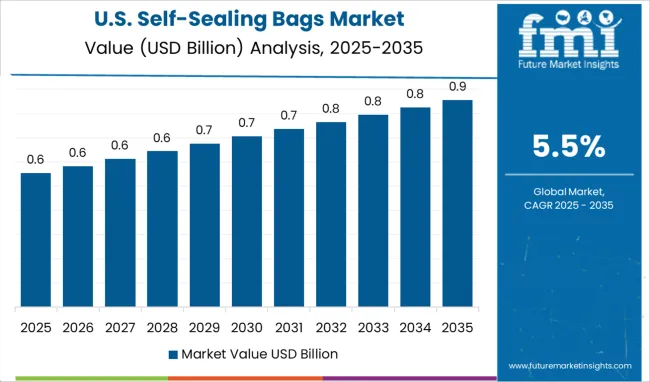
As per the self-sealing bags market analysis, the market share of North America is projected to account for 26% in 2025. The USA is expected to witness healthy growth. However, Canada is predicted to grow at a faster rate during the forecast period than the USA, which is expected to experience healthy growth.
During the forecast period, it is anticipated that the regional market will be significantly influenced by rising demand for advanced packaging types like pouches, liners, bags, and self-sealing bags, among others.
Another significant factor boosting the industry's growth and the region’s self-sealing bags market share is the rising popularity of e-commerce, food, and drinks among young people. Additionally, players have been significantly innovating in the market due to the rising demand for self-sealing bags.
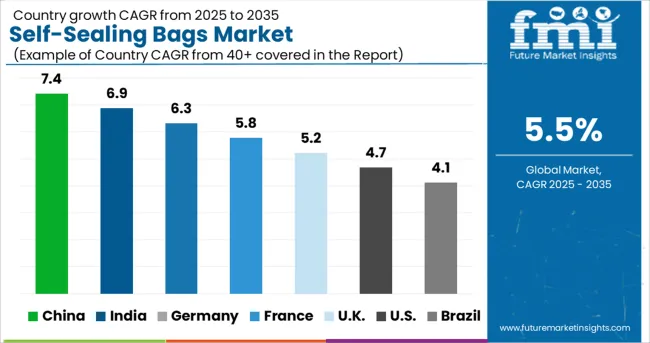
The regions of Europe are where self-seal bubble bags are primarily produced using polymers like polyethylene and polyethylene terephthalate, and the same is likely to contribute to the region’s market share of 21% in 2025.
Additionally, it is predicted that the market for permanent self-seal bubble bags grows exponentially over the course of the forecast period as a result of the expanding E-commerce sector.
The rapid global expansion of the various manufacturing sectors, which fuelled market growth during the assessment years, is attributed to the expansion of the Europe plastic protective packaging market.
In 2005, the simple bag was established as a sole proprietorship. This served as the official opening of a business that specialized in the purchase of carrier bags and other types of packaging.
After a change in ownership in 2008, the company, which was still run as a sole proprietorship, prospered under the name simple bag Martin Tomcok e.K. Martin Tomcok is the owner of the business, which is listed in the Gelsenkirchen commercial register.
This company fulfills the demands and requests of customers while also paying close attention to the details. The business philosophy is to provide customers with the best possible price that is also economical, even for small order quantities.
The simple bag is able to meet customer requirements more effectively and quickly than large service providers on shorter notice due to the quick decision-making and communication channels, where customized solutions can also be implemented.
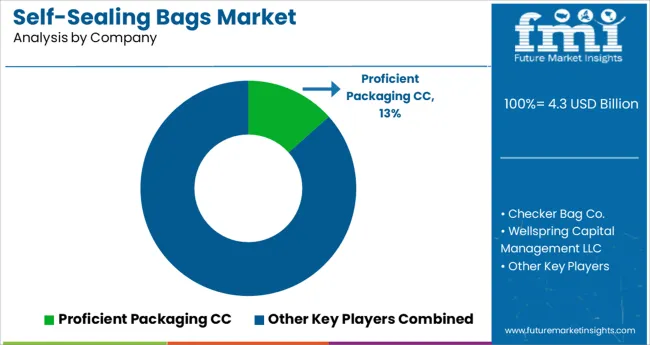
Proficient Packaging CC, Checker Bag Co., Ampac Holdings, LLC, Weldbank Plastic Co Ltd., Universal Plastic, Prism Pak, Inc., Ernest Cummins Printers Ltd., Mapol S.L., Polytec Kunststoffverarbeitung GmbH & Co. KG, Beauty Group Ltd. are a few prominent players in the market.
Leading market participants in self-sealing bags are concentrating on joint ventures and technological innovations with other market participants in developing economies, in addition to making significant investments in research and development.
| Report Attribute | Details |
|---|---|
| Growth Rate | CAGR of 5.5% from 2025 to 2035 |
| Base Year for Estimation | 2024 |
| Historical Data | 2014 to 2024 |
| Forecast Period | 2025 to 2035 |
| Quantitative Units | Revenue in USD Million and CAGR from 2025 to 2035 |
| Report Coverage | Revenue Forecast, Volume Forecast, Company Ranking, Competitive Landscape, Growth Factors, Trends, and Pricing Analysis |
| Segments Covered | Material Type, Bag Type, Bag Size, End Use, Region |
| Regions Covered | North America; Latin America; Western Europe; Eastern Europe; Asia Pacific; Japan; The Middle East and Africa |
| Key Countries Profiled | United States of America, Canada, Brazil, Argentina, Germany, United Kingdom, France, Spain, Italy, Nordics, BENELUX, Australia & New Zealand, China, India, ASIAN, GCC Countries, South Africa |
| Key Companies Profiled |
Proficient Packaging CC; Checker Bag Co.; Ampac Holdings, LLC; Weldbank Plastic Co Ltd.; Universal Plastic; Prism Pak, Inc.; Ernest Cummins Printers Ltd.; Mapol S.L.; Polytec Kunststoffverarbeitung GmbH & Co. KG; Beaufy Group Ltd. |
| Customization | Available Upon Request |
The global self-sealing bags market is estimated to be valued at USD 4.3 USD billion in 2025.
It is projected to reach USD 7.3 USD billion by 2035.
The market is expected to grow at a 5.5% CAGR between 2025 and 2035.
The key product types are polyethylene, bopp and cellophane.
renewable segment is expected to dominate with a 36.5% industry share in 2025.






Our Research Products

The "Full Research Suite" delivers actionable market intel, deep dives on markets or technologies, so clients act faster, cut risk, and unlock growth.

The Leaderboard benchmarks and ranks top vendors, classifying them as Established Leaders, Leading Challengers, or Disruptors & Challengers.

Locates where complements amplify value and substitutes erode it, forecasting net impact by horizon

We deliver granular, decision-grade intel: market sizing, 5-year forecasts, pricing, adoption, usage, revenue, and operational KPIs—plus competitor tracking, regulation, and value chains—across 60 countries broadly.

Spot the shifts before they hit your P&L. We track inflection points, adoption curves, pricing moves, and ecosystem plays to show where demand is heading, why it is changing, and what to do next across high-growth markets and disruptive tech

Real-time reads of user behavior. We track shifting priorities, perceptions of today’s and next-gen services, and provider experience, then pace how fast tech moves from trial to adoption, blending buyer, consumer, and channel inputs with social signals (#WhySwitch, #UX).

Partner with our analyst team to build a custom report designed around your business priorities. From analysing market trends to assessing competitors or crafting bespoke datasets, we tailor insights to your needs.
Supplier Intelligence
Discovery & Profiling
Capacity & Footprint
Performance & Risk
Compliance & Governance
Commercial Readiness
Who Supplies Whom
Scorecards & Shortlists
Playbooks & Docs
Category Intelligence
Definition & Scope
Demand & Use Cases
Cost Drivers
Market Structure
Supply Chain Map
Trade & Policy
Operating Norms
Deliverables
Buyer Intelligence
Account Basics
Spend & Scope
Procurement Model
Vendor Requirements
Terms & Policies
Entry Strategy
Pain Points & Triggers
Outputs
Pricing Analysis
Benchmarks
Trends
Should-Cost
Indexation
Landed Cost
Commercial Terms
Deliverables
Brand Analysis
Positioning & Value Prop
Share & Presence
Customer Evidence
Go-to-Market
Digital & Reputation
Compliance & Trust
KPIs & Gaps
Outputs
Full Research Suite comprises of:
Market outlook & trends analysis
Interviews & case studies
Strategic recommendations
Vendor profiles & capabilities analysis
5-year forecasts
8 regions and 60+ country-level data splits
Market segment data splits
12 months of continuous data updates
DELIVERED AS:
PDF EXCEL ONLINE
Industry Share Analysis for Self-Sealing Bags Companies
Polybags Market Size and Share Forecast Outlook 2025 to 2035
Net Bags Market
VCI Bags Market
Sandbags Market
Leno Bags Market Size and Share Forecast Outlook 2025 to 2035
Silo bags Market Size and Share Forecast Outlook 2025 to 2035
Food Bags Market Share, Size, and Trend Analysis for 2025 to 2035
Competitive Breakdown of Silo Bag Manufacturers
Paper Bags Market Size and Share Forecast Outlook 2025 to 2035
Jumbo Bags Market Size and Share Forecast Outlook 2025 to 2035
Blood Bags Market Size and Share Forecast Outlook 2025 to 2035
Craft Bags Market Growth, Trends, Forecast 2025 to 2035
Market Share Breakdown of Craft Bags Manufacturers
Competitive Breakdown of Paper Bags Providers
Market Share Analysis of Jumbo Bags & Key Players
Grout Bags Market Demand & Construction Industry Trends 2024 to 2034
Sugar Bags Market
Cotton Bags Market Size and Share Forecast Outlook 2025 to 2035
Refuse Bags Market Size and Share Forecast Outlook 2025 to 2035

Thank you!
You will receive an email from our Business Development Manager. Please be sure to check your SPAM/JUNK folder too.
Chat With
MaRIA